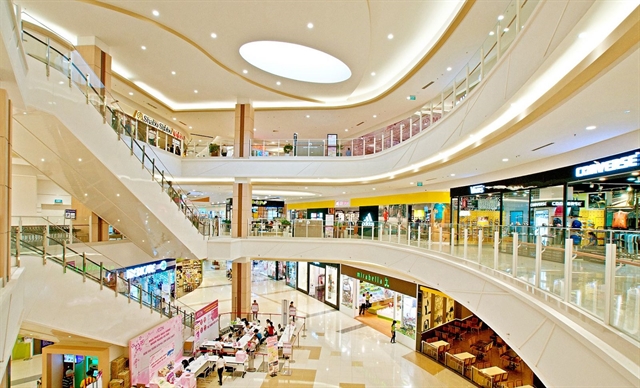 |
| In 2022, the retail market in general and townhouses in particular recovered with a better occupancy rate, but the recovery has not reached the level of the pre-COVID-19 period. Photo tapchixaydung.vn |
HÀ NỘI The retail space market has the opportunity to grow strongly in 2023 with the forecast of the recovery of the retail industry, especially with new investment of foreign brands in Việt Nam.
Many retail brands are looking at Việt Nam because the economy is strong, and they see the potential. Brands are diverse and range from luxury to mid-market brands, said Nick Bradstreet, head of Asia Pacific Retail, Savills. For example, Lotte is completing a new project, and it is expected to welcome international brands.
"The challenge Việt Nam is facing is that there are not enough shopping centres being built to meet the demand from international retailers," he said.
Việt Nam’s economy is growing quickly, which creates an attractive retail outlook. By 2025, Việt Nam will be the third largest economy in Southeast Asia, following Indonesia and Thailand. The country is vibrant and increasingly wealthy, and there is a dynamic population of young people.
Retailers want well-designed and managed properties with a dynamic tenant mix. They also want landlords to advertise and promote the spaces to draw in traffic, Bradstreet said. Central Group from Thailand is looking to invest more money in Việt Nam, and this is likely to attract international retailers because they trust the products. It might be harder for local developers and landlords because they are unknown on the international scene. Relationships are essential to attracting international retailers.
Besides, large cities such as Hà Nội, Đà Nẵng and HCM City, “tourist hubs, like Hội An, present opportunities, especially for pop-up stores during the high season. All the ingredients are there for Hội An, it just needs a well-planned and well-designed shopping centre,” Bradstreet said.
According to Bradstreet, everybody likes a well-managed shopping centre. Shopping centres deliver experiences. A prime example is Siam Paragon in Bangkok. It’s got all the big brands, people go and spend time with their friends, and parking and public transport are convenient. Shopping centres like this are popular in mainland China, Hong Kong, Thailand, and Việt Nam is no exception.
New suburban shopping centres and Lotte’s new project will be successful because people will be happy to go. The difficulty is that there are not enough shopping centres. Usually, there are shopping malls where all the luxury brands can be together or where fast fashion brands like Zara and H&M be grouped, but in Hà Nội, this is still very difficult to achieve.
“In the past, wealthy customers in Việt Nam travelled to Paris, Dubai, or Singapore and bought goods overseas. Before COVID, Vietnamese shoppers were spending overseas," he said.
However, with the lockdowns and restrictions over the last few years, they spent in Việt Nam and sales increased dramatically. Even today, luxury sales are extremely strong even though people are beginning to travel,” he said.
“The luxury market is interesting because there is a VIP business model. If someone shops at Louis Vuitton or Christian Dior, they will get to know them and will give them VIP treatment with dinners or gifts. So even if shoppers go overseas to buy a bag, they will still get a store from their local store when something new comes in. The relationship between customers and retailers has become stronger.”
E-commerce is now a vital sales avenue, and retailers have physical and online stores. However, physical stores deliver the experiential side of retail and can demonstrate the strength of a brand, its products, and its people. This plays an important role in how people feel about a brand and loyalty comes from that. Savills has seen people return to stores post-COVID, and physical spaces are important, Bradstreet said.
Luxury brands don’t rely too much on e-commerce because luxury retail is about service. When customers go to stores like Prada or Louis Vuitton, they walk out feeling good and often share this experience with their friends. However, when it comes to brands like Zara or H&M, getting delivery at home is okay because there isn’t the same level of aspiration or exclusivity.
In 2022, the retail market in general and townhouses in particular already recovered with a better occupancy rate, but the recovery has not reached the level of the pre-COVID-19 period, according to Savills.
The rental price of retail space also recorded an increase against the COVID-19 period. Of course, the recovery is still not as the performance before the pandemic due to the impacts of the economic situation at present and the landlords' psychology of comparison in the price at present against that in the pre-pandemic, said Hoàng Diệu Trang, Senior Leasing Manager for Savills Vietnam in Hanoi Branch.
Therefore, to further develop the market of townhouses for rent in 2023, there needs to be cooperation between customers and landlords in adjusting rent expectations.
In addition, the advantages of Việt Nam, such as a large and young population, and the young people's higher shopping needs than previous generations, will play a big role in attracting retail brands to the market, leading to the development of townhouse-retail in the future.
However, the retail real estate market in Việt Nam has high competitiveness, so retailers must constantly innovate to survive.
For the occupancy rate, the market still needs to continue adjusting to increase this rate in the near future.
Meanwhile, homeowners need to be aware of strict requirements on retail space from the brands. Brands need retail space with good quality in building and technical conditions.
Therefore, besides the good location of retail space, the landlord needs to provide more professional services and have more investment in the quality of the space to attract big brands.
In fact, if the townhouse space does not meet the desired brand criteria, they will prioritise Grade A retail space, which has special locations, reputable investors and properly-invested retail space.
Besides that, it cannot ignore the adverse effects of global macroeconomic conditions on consumption. Moreover, tourism has not really boomed, which also affects consumption, so it is necessary to have policies to support enterprises and Vietnamese brands to develop in many industries, thereby encouraging domestic consumption. VNS
 PMASTER SERVICES
PMASTER SERVICES


